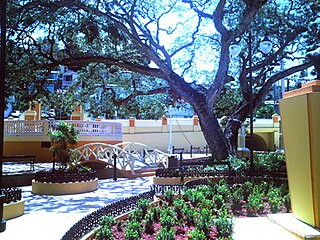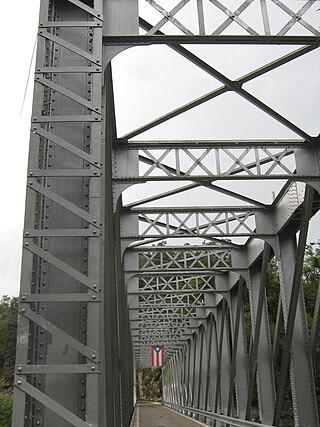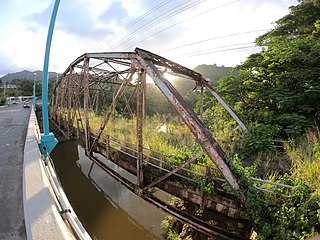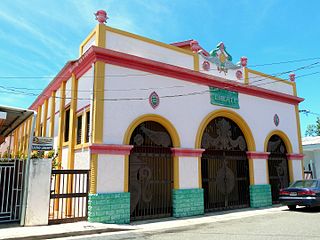
The Las Cabañas Bridge is a historic highway bridge in Adjuntas municipality, Puerto Rico. Built in 1919 to provide access to a key coffee-producing region, it was financed by nearby plantations through public subscription. Designer Rafael Nones and builder Félix Benítez Rexach, two of the most prominent figures in Puerto Rican bridge construction in the early 20th century, used a unique combination of steel and concrete technologies to produce a girder design unlike any other on the island and possibly beyond.

El Parterre is a landscaped park in Aguadilla, Puerto Rico, that was built in 1851. The park encloses the Ojo de Agua, also referred to as Manantial Ojo de Agua, a natural spring which was a source of water for Spanish soldiers, and the source of a small rivulet locally called Chico River which empties into the Aguadilla Bay.

The Villarán Bridge, also known as the Canóvanas Bridge, is a historic bridge over the Canóvanas River in Canóvanas, Puerto Rico. Built in 1892 on the highway between Río Piedras and Río Grande, its iron superstructure was imported from Europe and set on masonry abutments. It is the best-preserved example of an Eiffel pony truss bridge in Puerto Rico or the United States. By 1994, the bridge had been replaced by an adjacent span for vehicular use, but it remained open for pedestrian use.

Manatí Bridge at Mata de Plátano, also known as Puente Juan José Jiménez and listed as Bridge #321 in Puerto Rico's bridge inventory, was built in 1905 in Hato Viejo, Ciales, Puerto Rico. It was listed on the National Register of Historic Places in 1995 and on the Puerto Rico Register of Historic Sites and Zones in 2001.

Bridge No. 122, spanning the Santiago River near Naguabo, Puerto Rico, is significant as "one of the earliest and most elegant examples of concrete beam bridges in Puerto Rico". Built in 1918, it was "futuristic" for its time and has noteworthy architectural detail relative to others. It was designed by Rafael Nones and built by Felix Benitez-Rexach, both engineers, both regarded as masters in their work. Its construction was financed by Puerto Rico's second public bond issue for public works, in 1916, which raised $2 million.

The Filardi House, also known as Casa Muñoz, is a historic house with ground-level commercial space in Yauco, Puerto Rico. It is notable for the extensive use of concrete sculptural ornamentation on its facade. Italian immigrant Vicente Filardi, a contractor with business in Ponce and Yauco, designed and built the house in 1916 with his sons Juan Bautista and Domingo. The younger Filardis were responsible for the integration of the elaborate decorative features with the overall Beaux-Arts plan, and later came to be recognized as experts in production of ornamental elements of cast concrete.

Edificio Oliver in Arecibo, Puerto Rico was built in 1914. The building houses government offices for the municipality of Arecibo.

Plata Bridge, listed in Puerto Rico's bridge inventory as Bridge #374 and now also known as Antiguo Puente Plata, was built in 1908. It is significant as "the only extant large multi span truss bridge in Puerto Rico", according to its nomination document for listing on the National Register of Historic Places. It includes two Parker truss spans and was built in 1908. It brought what is now Puerto Rico Highway 167 across the Rio La Plata, spanning from Bayamon municipality and into Naranjito, and connected several mountain towns to the coastal road along Puerto Rico's north coast.

The Hondo River Bridge was a historic bridge over the Hondo River in Comerío municipality, Puerto Rico. As of 1995, it was the oldest bridge truss in Puerto Rico, employing a double Warren pony truss design and unique open web transverse joists. It was originally installed in 1881 as one of three spans of the Reyes Católicos Bridge over the Plata River on the San Juan–Mayagüez road, using metal parts fabricated in Belgium. After a hurricane destroyed one of the other spans of the Reyes Católicos Bridge in 1899, this surviving span was moved and re-installed on new abutments under the supervision of engineer Rafael Nones in 1908, as part of the Comerío–Barranquitas road. It was finally removed and replaced in 2001.

The General Norzagaray Bridge is a brick and masonry barrel vault bridge built in 1855 in San Juan, Puerto Rico. Also known as Puente de los Frailes, it brings what is now Puerto Rico Highway 873 across Frailes Creek, a tributary to the Guaynabo River. It has eight 9.8-metre (32 ft) barrel vault spans. Its total length is 120.7 metres (396 ft) and its roadway width is 7.00 metres (22.97 ft). It was listed on the National Register of Historic Places (NRHP) in 1995, and on the Puerto Rico Register of Historic Sites and Zones in 2000.

The Cayey Bridge, also known as Puente de Cayey, is an iron lateral lattice girder bridge in Puerto Rico that was built in 1891. It brings Puerto Rico Highway 15 over the Guamaní River. Despite its name, its actually closer to the city of Guayama and not Cayey.

The Silva Bridge is a Pratt pony truss bridge in Puerto Rico which was built in 1897. It was listed on the National Register of Historic Places in 1995 and on the Puerto Rico Register of Historic Sites and Zones in 2000.
The Río Matón Bridge, in Matón Abajo, a barrio of Cayey, Puerto Rico, was built in 1886. It was listed on the National Register of Historic Places in 1995 and on the Puerto Rico Register of Historic Sites and Zones in 2000.

The Edificio Alcaldia is a historic building in Carolina, Puerto Rico. The building was designed by Puerto Rican architect Rafael Carmoega, then an architect of the Department of the Interior, with assistance of Francisco Garden. The Department of the Interior also built the building. In addition to serving as the City Hall, the facilities included government offices, the Municipal Jail, and a Medical Office.

Cambalache Bridge or Puente Francés is a bridge built in 1893 which spans the Río Grande de Arecibo from Cambalache barrio to Tanamá barrio in Arecibo. It is located 100 meters west of Puerto Rico Highway 2, at kilometer 72.

Marqués de la Serna Bridge, also known as Bayamón Bridge and Bridge #379, is a historic rolled iron segmented arch bridge that crosses the Bayamón River, located between the barrios of Bayamón Pueblo and Juan Sánchez in the Puerto Rican municipality of Bayamón. Its lowered arches, similar to those of the Pont d'Arcole in Paris, are unique in Puerto Rico. The bridge was added to the United States National Register of Historic Places on July 19, 1995, and to the Puerto Rico Register of Historic Sites and Zones in 2000.
Padre Íñigo Bridge, also known as the Coamo Bridge or Bridge #174, is a historic lattice girder bridge that crosses the Coamo River in the municipality of the same name in southern Puerto Rico. It was added to the United States National Register of Historic Places in 1995, and to the Puerto Rico Register of Historic Sites and Zones in 2001.

Teatro Liberty is a historic theater and performing arts venue located in Quebradillas Pueblo, the administrative and historic center of the municipality of Quebradillas, Puerto Rico. It was designed by Arcilio Rosa as both a music venue and a silent movie theater. It was the first venue of its kind to be built in Quebradillas and it hosted numerous musical events popular at the time such as zarzuelas and operettas, in addition to classical Spanish plays. The theater has been listed in the National Register of Historic Places since 1989 and on the Puerto Rico Register of Historic Sites and Zones since 2000 for being a prime example of the 1920s architecture cultural and performing arts venues vernacular architecture in the island that is highly inspired by Spanish Colonial architecture. It preserves its architectural integrity and was last restored in 1978 with upgrades being made to the lobby and main stage.

The Río Piedras Bridge or Piedras River Bridge, also designated as Bridge #3, is a historic 19th-century barrel vault bridge located in the former town of Río Piedras, today part of the city of San Juan, Puerto Rico, that spans across the Piedras River. The bridge was built in 1853 as part of the development of the Carretera Central that linked San Juan to Ponce, making it the oldest still-existing bridge of said route. Today the bridge is still stable and usable, and it can be found near the entrance of the University of Puerto Rico Botanical Garden. It was added to the National Register of Historic Places in 1995 and on the Puerto Rico Register of Historic Sites and Zones in 2000, and it is considered to be the best-preserved example of a Spanish masonry arch bridge anywhere in Puerto Rico and the United States.
The Prieto River Bridge, also known as Bridge #261 and better known as the "Del Treinta" Bridge, is a historic bridge located in the Indiera Alta barrio of the municipality of Maricao, Puerto Rico. It was built in 1924 as part of a highway construction boom that occurred in the island during the 1920s. The bridge spans across the Prieto River in the Luis Muñoz Marín Scenic Route and was added to the National Register of Historic Places in 1995 and to the Puerto Rico Register of Historic Sites and Zones in 2001.



















